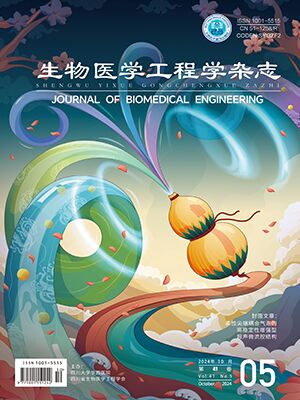| 1. |
HOLZWARTH J M, MA P X. Biomimetic nanofibrous scaffolds for bone tissue engineering[J]. Biomaterials, 2011, 32(36):9622-9629.
|
| 2. |
黄艳, 樊瑜波.力学因素影响骨髓间充质干细胞活性的研究进展[J].生物医学工程学杂志, 2010, 27(4):920-923.
|
| 3. |
李波, 何华伟, 廖晓玲, 等.纳米骨组织工程支架材料生物学效应研究进展[J].生物医学工程学杂志, 2011, 28(5):1035-1039.
|
| 4. |
HUANG Y, ZHOU G, ZHENG L, et al. Micro-/Nano-sized hydroxyapatite directs differentiation of rat bone marrow derived mesenchymal stem cells towards an osteoblast lineage[J]. Nanoscale, 2012, 4(7):2484-2490.
|
| 5. |
周钢, 阿茹罕, 黄艳, 等.不同尺度的纳米羟基磷灰石对大鼠骨髓间充质干细胞分化的影响[C]//第十届全国生物力学学术会议暨第十二届全国生物流变学学术会议论文摘要汇编.成都:中国力学学会, 2012.
|
| 6. |
LIU X W, OKADA M, MAEDA H, et al. Hydroxyapatite/biodegradable poly(L-lactide-co-ε-caprolactone) composite microparticles as injectable scaffolds by a Pickering emulsion route[J]. Acta Biomater, 2011, 7(2):821-828.
|
| 7. |
JEGAL S H, PARK J H, KIM J H, et al. Functional composite nanofibers of poly(lactide-co-caprolactone) containing gelatin-apatite bone mimetic precipitate for bone regeneration[J]. Acta Biomater, 2011, 7(4):1609-1617.
|
| 8. |
HEO S J, KIM S E, WEI J, et al. Fabrication and characterization of novel nano-and micro-HA/PCL composite scaffolds using a modified rapid prototyping process[J]. J Biomed Mater Res A, 2009, 89(1):108-116.
|
| 9. |
MOHAMED K R, BEHEREI H H, E L BASSYOUNI G T, et al. Fabrication and mechanical evaluation of hydroxyapatite/oxide nano-composite materials[J]. Mater Sci Eng C Mater Biol Appl, 2013, 33(7):4126-4132.
|
| 10. |
KAVYA K C, DIXIT R, JAYAKUMAR R, et al. Synthesis and characterization of chitosan/chondroitin sulfate/nano-SiO2 composite scaffold for bone tissue engineering[J]. J Biomed Nanotechnol, 2012, 8(1):149-160.
|
| 11. |
VENKATESAN J, RYU B, SUDHA P N, et al. Preparation and characterization of chitosan-carbon nanotube scaffolds for bone tissue engineering[J]. Int J Biol Macromol, 2012, 50(2):393-402.
|
| 12. |
PATTNAIK S, NETHALA S, TRIPATHI A, et al. Chitosan scaffolds containing silicon dioxide and zirconia nano particles for bone tissue engineering[J]. Int J Biol Macromol, 2011, 49(5):1167-1172.
|
| 13. |
SICCHIERI L G, CRIPPA G E, DE OLIVEIRA P T, et al. Pore size regulates cell and tissue interactions with PLGA-CaP scaffolds used for bone engineering[J]. J Tissue Eng Regen Med, 2012, 6(2):155-162.
|
| 14. |
MELCHELS F P W, TONNARELLI B, OLIVARES A L, et al. The influence of the scaffold design on the distribution of adhering cells after perfusion cell seeding[J]. Biomaterials, 2011, 32(11):2878-2884.
|
| 15. |
MASTROGIACOMO M, SCAGLIONE S, MARTINETTI R, et al. Role of scaffold internal structure on in vivo bone formation in macroporous calcium phosphate bioceramics[J]. Biomaterials, 2006, 27(17):3230-3237.
|
| 16. |
尤飞, 姚远, 胡庆夕.仿生骨支架微观孔结构的构建与评价[J].机械工程学报, 2011, 47(1):138-144.
|
| 17. |
LIU X, RAHAMAN M N, FU Q. Bone regeneration in strong porous bioactive glass(13-93) scaffolds with an oriented microstructure implanted in rat calvarial defects[J]. Acta Biomater, 2013, 9(1):4889-4898.
|
| 18. |
MITSAK A G, KEMPPAINEN J M, HARRIS M T, et al. Effect of polycaprolactone scaffold permeability on bone regeneration in vivo[J]. Tissue Eng Part A, 2011, 17(13-14):1831-1839.
|
| 19. |
JEONG C G, ZHANG H N, HOLLISTER S J. Three-dimensional poly(1, 8-octanediol-co-citrate) scaffold pore shape and permeability effects on sub-cutaneous in vivo chondrogenesis using primary chondrocytes[J]. Acta Biomater, 2011, 7(2):505-514.
|
| 20. |
FAN J, JIA X L, HUANG Y, et al. Greater scaffold permeability promotes growth of osteoblastic cells in a perfused bioreactor[J]. J Tissue Eng Regen Med, 2013:[Epub ahead of print].
|
| 21. |
LIU X, RAHAMAN M N, FU Q, et al. Porous and strong bioactive glass(13-93) scaffolds prepared by unidirectional freezing of camphene-based suspensions[J]. Acta Biomater, 2012, 8(1):415-423.
|
| 22. |
LEE K W, WANG S, FOX B C, et al. Poly(propylene fumarate) bone tissue engineering scaffold fabrication using stereolithography:effects of resin formulations and laser parameters[J]. Biomacromolecules, 2007, 8(4):1077-1084.
|
| 23. |
SANDINO C, LACROIX D. A dynamical study of the mechanical stimuli and tissue differentiation within a CaP scaffold based on micro-CT finite element models[J]. Biomech Model Mechanobiol, 2011, 10(4):565-576.
|
| 24. |
DIAS M R, FERNANDES P R, GUEDES J M, et al. Permeability analysis of scaffolds for bone tissue engineering[J]. J Biomech, 2012, 45(6):938-944.
|
| 25. |
伍权, 张祥林, 吴斌, 等.基于挤出沉积成形技术的多孔生物支架制备[J].华中科技大学学报:自然科学版, 2011, 39(12):33-36.
|
| 26. |
SHIN J H, LEE J W, JUNG J H, et al. Evaluation of cell proliferation and differentiation on a poly(propylene fumarate) 3D scaffold treated with functional peptides[J]. J Mater Sci, 2011, 46(15):5282-5287.
|
| 27. |
ZHANG H F, LI Z J, FU X, et al. Interactions of bone marrow stromal cells with native and RGD surface modified acellular bone matrix:a biocompatibility study[J]. Arch Med Res, 2013, 44(1):69-74.
|
| 28. |
SUN X J, PENG W, YANG Z L, et al. Heparin-chitosan-coated acellular bone matrix enhances perfusion of blood and vascularization in bone tissue engineering scaffolds[J]. Tissue Eng Part A, 2011, 17(19-20):2369-2378.
|
| 29. |
LI J, QU R M, DAI J X, et al. Mechanical and physicochemical properties of xenogeneic bone scaffold materials[J]. J Clin Rehabil Tissue Eng Res, 2008, 12(45):8931-8934.
|
| 30. |
CHEN Q, YANG Z, SUN S, et al. Adipose-derived stem cells modified genetically in vivo promote reconstruction of bone defects[J]. Cytotherapy, 2010, 12(6):831-840.
|




